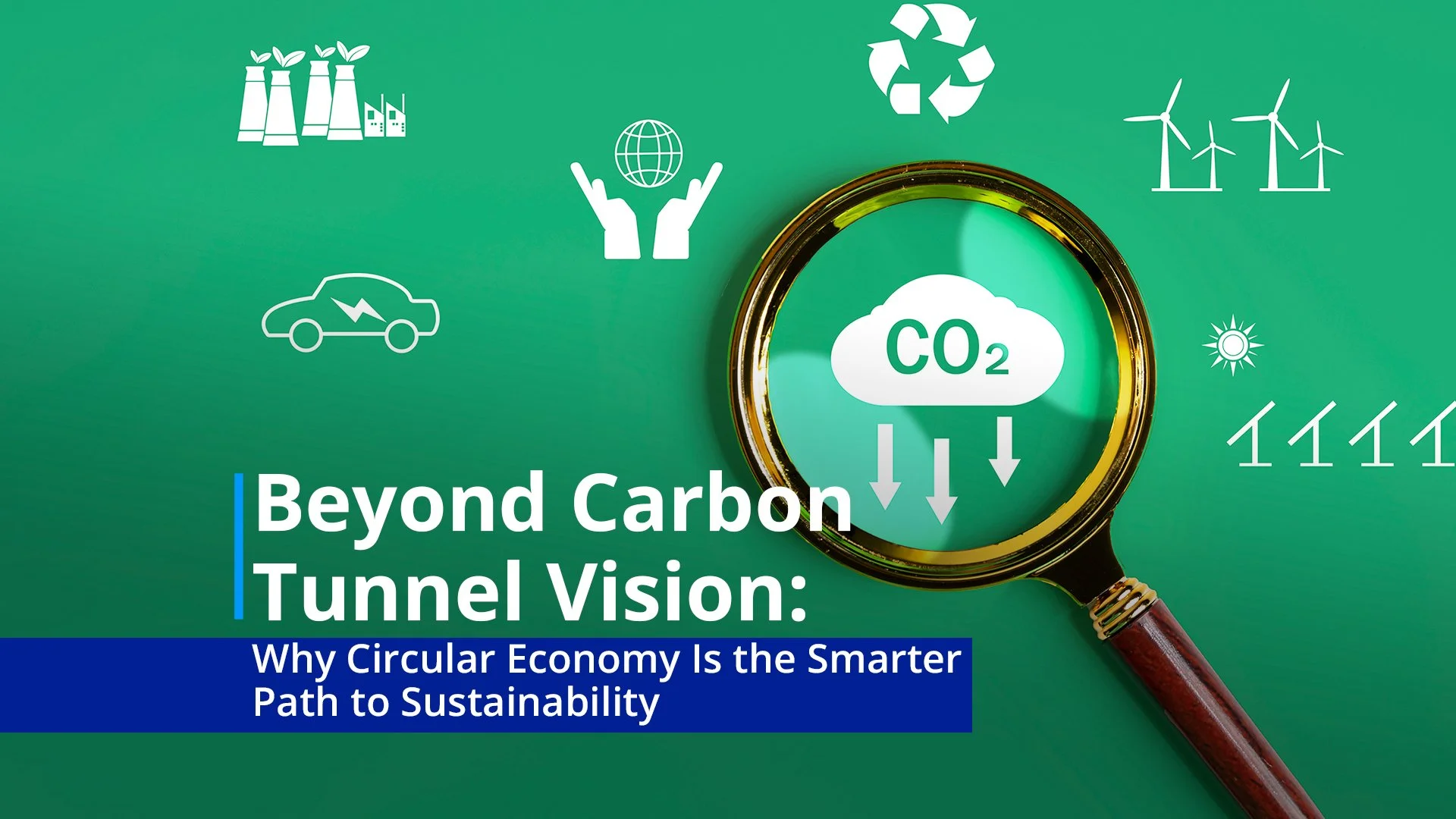Beyond Carbon Tunnel Vision: Why Circular Economy Is the Smarter Path to Sustainability
If you've been anywhere near a sustainability conversation lately, chances are it revolved around carbon emissions. From corporate strategies to product design, carbon has become the primary yardstick by which we measure environmental responsibility.
It makes sense: climate change is an urgent global crisis, and we absolutely need to reduce emissions.
But there is a catch: when carbon becomes the only lens through which we look at sustainability, we risk developing what many now call "carbon tunnel vision." This term describes the growing tendency to zero in on carbon reductions while overlooking other equally pressing environmental challenges like biodiversity loss, water scarcity, pollution, and even social impacts across supply chains.
Tackling carbon alone isn't enough. Some actions that lower emissions can cause unexpected harm elsewhere. We need to broaden our perspective to build truly sustainable, resilient businesses. And that's where the circular economy comes in: offering a more holistic, balanced, and ultimately more effective path forward.
When Cutting Carbon Creates New Problems
It's easy to assume that any material or solution with a lower carbon footprint is automatically "sustainable." Unfortunately, that's not always the case.
Take biobased plastics, for example. These are often made from renewable crops like corn or sugarcane, and they're promoted as greener alternatives to conventional plastics, thanks to their lower carbon footprint. But what's left out of the story is their hidden environmental cost: large-scale crop production can drive deforestation and habitat loss, displace wildlife and reduce biodiversity. Some of these crops also rely heavily on fertilisers and pesticides, which can pollute rivers and soil.
Natural rubber faces similar trade-offs. It's often seen as a lower-carbon option than synthetic, petroleum-based rubber. But again, the story doesn't end there. Expanding rubber plantations has been a major driver of deforestation in Southeast Asia and Africa, threatening species and ecosystems. In some cases, these plantations have been linked to land rights conflicts, where local communities are pushed aside to make way for industrial-scale farming.
Even timber, widely regarded as a "climate-friendly" building material—carries risks. Without responsible sourcing, timber harvesting can devastate forests, damage the soil, and disrupt local water cycles. Monoculture plantations can replace biodiverse natural habitats with sterile, single-species landscapes that are poor in wildlife and prone to disease.
In each of these cases, we see a common thread: solutions that reduce carbon in the short term can create severe environmental damage elsewhere if we're not careful. We are not saying that biobased plastics, natural rubber or timber are worst options than fossil-oil based plastics, synthetic rubber or other materials, but we are saying that they come with trade-offs and it's important to be aware of them.
Circular Economy: A More Balanced Approach
Moving the focus from carbon emissions to the circular economy often allows us to address multiple environmental dimensions simultaneously. Most circular strategies will reduce your carbon footprint while protecting biodiversity and keeping out of use harmful substances that pollute the water and soil and endanger biodiversity and human health.
For example, extending the lifespan of products and components means fewer raw materials need to be extracted in the first place, protecting natural habitats from mining, logging, or agricultural expansion. Simultaneously, it reduces carbon emissions. Recycling materials reduces the need for virgin production, reducing carbon emissions, avoiding deforestation and habitat damage from oil extraction, crop plantations for biobased plastics feedstocks or intensive rubber tree plantations. Circular systems also avoid hazardous chemicals, ensuring that products remain safe to recycle and don't leach toxins into soils and waterways, protecting both biodiversity and human health.
Let's not forget about local economies. Circular models often involve more localised production, repair, and remanufacturing, cutting transport emissions and supporting local jobs while reducing land and resource pressures elsewhere.
In short, circularity naturally broadens the sustainability lens. It connects climate action with biodiversity conservation, pollution prevention, and social well-being.
How We Recommend Moving Beyond Carbon Tunnel Vision
At Oakdene Hollins, we work with companies across industries that are ready to move beyond carbon tunnel vision—but aren't always sure where to start.
Our first piece of advice is to make circularity your starting point. Most circular actions reduce carbon and deliver co-benefits for biodiversity and pollution prevention. It's a win-win.
Next, we encourage businesses to look beyond simple product carbon footprints (PCF). While calculating product carbon footprints is valuable, it only gives you a slice of the picture. Instead, we recommend using Life Cycle Assessments (LCA), which provide a more comprehensive view of multiple environmental impacts, including carbon, water, ozone depletion, land use, and toxicity. LCA helps you spot trade-offs, avoid unintended consequences, and make smarter, more balanced decisions.
Finally, we advise companies to integrate biodiversity-specific targets alongside their climate goals. Frameworks like the Science-Based Targets for Nature (SBTN) are helping businesses set science-based, measurable goals for ecosystem protection and restoration, ensuring they are reducing emissions while actively safeguarding nature.
Conclusion: It's Time to Broaden the Lens
The climate crisis demands urgent action—but focusing solely on carbon is not the answer. When we develop tunnel vision around emissions, we risk causing damage elsewhere, creating new problems even as we solve others.
The circular economy offers a smarter, more holistic approach. It helps businesses cut carbon while protecting biodiversity, reducing pollution, and using resources more wisely.
We'd love to hear from you if you're ready to explore a more balanced, future-proof sustainability strategy.
Let's talk.

